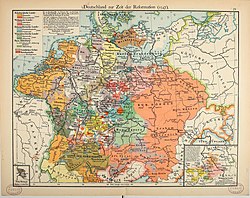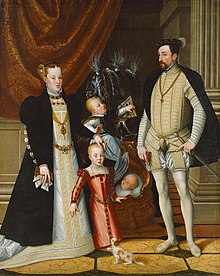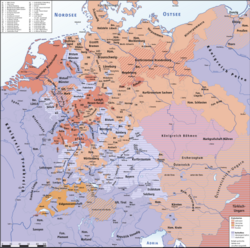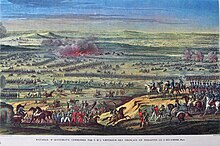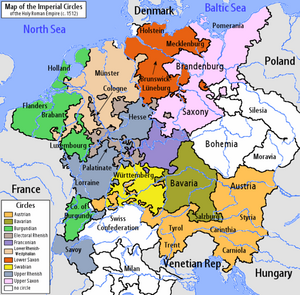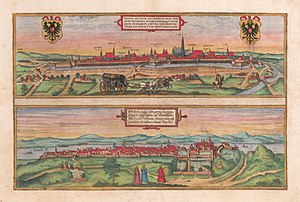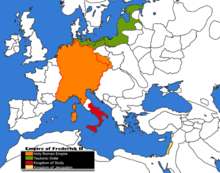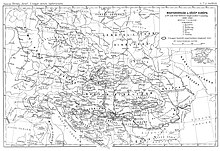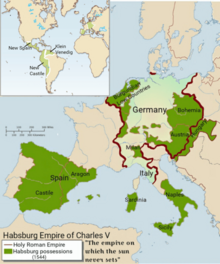Holy Roman Empire
On 25 December 800, Pope Leo III crowned the Frankish king Charlemagne Roman emperor, reviving the title more than three centuries after the fall of the Western Roman Empire in 476. The title lapsed in 924, but was revived in 962 when Otto I was crowned emperor by Pope John XII, as Charlemagne's and the Carolingian Empire's successor. From 962 until the 12th century, the empire was one of the most powerful monarchies in Europe. It depended on cooperation between emperor and vassals; this was disturbed during the Salian period. The empire reached the apex of territorial expansion and power under the House of Hohenstaufen in the mid-13th century, but overextension led to a partial collapse. The imperial office was traditionally elective by the mostly German prince-electors. In theory and diplomacy, the emperors were considered the first among equals of all of Europe's Catholic monarchs.
A process of Imperial Reform in the late 15th and early 16th centuries transformed the empire, creating a set of institutions which endured until its final demise in the 19th century. On 6 August 1806, Emperor Francis II abdicated and formally dissolved the empire following the creation by French emperor Napoleon of the Confederation of the Rhine from German client states loyal to France.
Name and general perception
Since Charlemagne, the realm was merely referred to as the Roman Empire. The term sacrum ("holy", in the sense of "consecrated") in connection with the medieval Roman Empire was used beginning in 1157 under Frederick I Barbarossa ("Holy Empire"): the term was added to reflect Frederick's ambition to dominate Italy and the Papacy. The form "Holy Roman Empire" is attested from 1254 onward.
The exact term "Holy Roman Empire" was not used until the 13th century, before which the empire was referred to variously as universum regnum ("the whole kingdom", as opposed to the regional kingdoms), imperium christianum ("Christian empire"), or Romanum imperium ("Roman empire"), but the Emperor's legitimacy always rested on the concept of translatio imperii, that he held supreme power inherited from the ancient emperors of Rome.
In a decree following the Diet of Cologne in 1512, the name was changed to the Holy Roman Empire of the German Nation (German: Heiliges Römisches Reich Deutscher Nation, Latin: Sacrum Imperium Romanum Nationis Germanicae), a form first used in a document in 1474. The adoption of this new name coincided with the loss of imperial territories in Italy and Burgundy to the south and west by the late 15th century, but also to emphasize the new importance of the German Imperial Estates in ruling the Empire due to the Imperial Reform. The Hungarian denomination "German Roman Empire" (Hungarian: Német-római Birodalom) is the shortening of this.
By the end of the 18th century, the term "Holy Roman Empire of the German Nation" fell out of official use. Contradicting the traditional view concerning that designation, Hermann Weisert has argued in a study on imperial titulature that, despite the claims of many textbooks, the name "Holy Roman Empire of the German Nation" never had an official status and points out that documents were thirty times as likely to omit the national suffix as include it.
In a famous assessment of the name, the political philosopher Voltaire remarked sardonically: "This body which was called and which still calls itself the Holy Roman Empire was in no way holy, nor Roman, nor an empire."
In the modern period, the Empire was often informally called the German Empire (Deutsches Reich) or Roman-German Empire (Römisch-Deutsches Reich). After its dissolution through the end of the German Empire, it was often called "the old Empire" (das alte Reich). Beginning in 1923, early twentieth-century German nationalists and Nazi Party propaganda would identify the Holy Roman Empire as the "First" Reich (Erstes Reich, Reich meaning empire), with the German Empire as the "Second" Reich and what would eventually become Nazi Germany as the "Third" Reich.
David S. Bachrach opines that the Ottonian kings actually built their empire on the back of military and bureaucratic apparatuses as well as the cultural legacy they inherited from the Carolingians, who ultimately inherited these from the Late Roman Empire. He argues that the Ottonian empire was hardly an archaic kingdom of primitive Germans, maintained by personal relationships only and driven by the desire of the magnates to plunder and divide the rewards among themselves but instead, notable for their abilities to amass sophisticated economic, administrative, educational and cultural resources that they used to serve their enormous war machine.
Until the end of the 15th century, the empire was in theory composed of three major blocs – Italy, Germany and Burgundy. Later territorially only the Kingdom of Germany and Bohemia remained, with the Burgundian territories lost to France. Although the Italian territories were formally part of the empire, the territories were ignored in the Imperial Reform and splintered into numerous de facto independent territorial entities. The status of Italy in particular varied throughout the 16th to 18th centuries. Some territories like Piedmont-Savoy became increasingly independent, while others became more dependent due to the extinction of their ruling noble houses causing these territories to often fall under the dominions of the Habsburgs and their cadet branches. Barring the loss of Franche-Comté in 1678, the external borders of the Empire did not change noticeably from the Peace of Westphalia – which acknowledged the exclusion of Switzerland and the Northern Netherlands, and the French protectorate over Alsace – to the dissolution of the Empire. At the conclusion of the Napoleonic Wars in 1815, most of the Holy Roman Empire was included in the German Confederation, with the main exceptions being the Italian states.
History
| History of Germany |
|---|
 |
Early Middle Ages
Carolingian Empire

As Roman power in Gaul declined during the 5th century, local Germanic tribes assumed control. In the late 5th and early 6th centuries, the Merovingians, under Clovis I and his successors, consolidated Frankish tribes and extended hegemony over others to gain control of northern Gaul and the middle Rhine river valley region. By the middle of the 8th century, the Merovingians were reduced to figureheads, and the Carolingians, led by Charles Martel, became the de facto rulers. In 751, Martel's son Pepin became King of the Franks, and later gained the sanction of the Pope. The Carolingians would maintain a close alliance with the Papacy.
In 768, Pepin's son Charlemagne became King of the Franks and began an extensive expansion of the realm. He eventually incorporated the territories of present-day France, Germany, northern Italy, the Low Countries and beyond, linking the Frankish kingdom with Papal lands.
Although antagonism about the expense of Byzantine domination had long persisted within Italy, a political rupture was set in motion in earnest in 726 by the iconoclasm of Emperor Leo III the Isaurian, in what Pope Gregory II saw as the latest in a series of imperial heresies. In 797, the Eastern Roman Emperor Constantine VI was removed from the throne by his mother, Empress Irene, who declared herself sole ruler. As the Latin Church only regarded a male Roman emperor as the head of Christendom, Pope Leo III sought a new candidate for the dignity, excluding consultation with the patriarch of Constantinople.
Charlemagne's good service to the Church in his defense of Papal possessions against the Lombards made him the ideal candidate. On Christmas Day of 800, Pope Leo III crowned Charlemagne emperor, restoring the title in the West for the first time in over three centuries. This can be seen as symbolic of the papacy turning away from the declining Byzantine Empire toward the new power of Carolingian Francia. Charlemagne adopted the formula Renovatio imperii Romanorum ("renewal of the Roman Empire"). In 802, Irene was overthrown and exiled by Nikephoros I and henceforth there were two Roman emperors.
After Charlemagne died in 814, the imperial crown passed to his son, Louis the Pious. Upon Louis' death in 840, it passed to his son Lothair, who had been his co-ruler. By this point the territory of Charlemagne was divided into several territories (cf. Treaty of Verdun, Treaty of Prüm, Treaty of Meerssen and Treaty of Ribemont), and over the course of the later 9th century the title of emperor was disputed by the Carolingian rulers of the Western Frankish Kingdom or West Francia and the Eastern Frankish Kingdom or East Francia, with first the western king (Charles the Bald) and then the eastern (Charles the Fat), who briefly reunited the Empire, attaining the prize. In the 9th century, Charlemagne and his successors promoted the intellectual revival, known as the Carolingian Renaissance. Some, like Mortimer Chambers, opine that the Carolingian Renaissance made possible the subsequent renaissances (even though by the early 10th century, the revival already diminished).
After the death of Charles the Fat in 888, the Carolingian Empire broke apart, and was never restored. According to Regino of Prüm, the parts of the realm "spewed forth kinglets", and each part elected a kinglet "from its own bowels". The last such emperor was Berengar I of Italy, who died in 924.
Post-Carolingian Eastern Frankish Kingdom
Around 900, East Francia's autonomous stem duchies (Franconia, Bavaria, Swabia, Saxony, and Lotharingia) reemerged. After the Carolingian king Louis the Child died without issue in 911, East Francia did not turn to the Carolingian ruler of West Francia to take over the realm but instead elected one of the dukes, Conrad of Franconia, as Rex Francorum Orientalium. On his deathbed, Conrad yielded the crown to his main rival, Henry the Fowler of Saxony (r. 919–936), who was elected king at the Diet of Fritzlar in 919. Henry reached a truce with the raiding Magyars, and in 933 he won a first victory against them in the Battle of Riade.
Henry died in 936, but his descendants, the Liudolfing (or Ottonian) dynasty, would continue to rule the Eastern kingdom or the Kingdom of Germany for roughly a century. Upon Henry the Fowler's death, Otto, his son and designated successor, was elected king in Aachen in 936. He overcame a series of revolts from a younger brother and from several dukes. After that, the king managed to control the appointment of dukes and often also employed bishops in administrative affairs. He replaced leaders of most of the major East Frankish duchies with his own relatives. At the same time, he was careful to prevent members of his own family from making infringements on his royal prerogatives.
Formation of the Holy Roman Empire

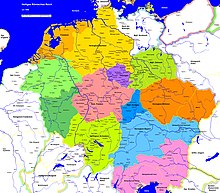
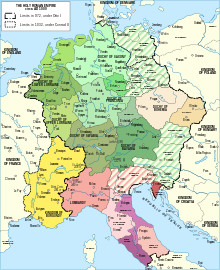
In 951, Otto came to the aid of Queen Adelaide of Italy, defeating her enemies, marrying her, and taking control over Italy. In 955, Otto won a decisive victory over the Magyars in the Battle of Lechfeld. In 962, Otto was crowned emperor by Pope John XII, thus intertwining the affairs of the German kingdom with those of Italy and the Papacy. Otto's coronation as emperor marked the German kings as successors to the empire of Charlemagne, which through the concept of translatio imperii, also made them consider themselves as successors to Ancient Rome. The flowering of arts beginning with Otto the Great's reign is known as the Ottonian Renaissance, centered in Germany but also happening in Northern Italy and France.
Otto created the imperial church system, often called "Ottonian church system of the Reich", which tied the great imperial churches and their representatives to imperial service, thus providing "a stable and long-lasting framework for Germany". During the Ottonian era, imperial women played a prominent role in political and ecclesiastic affairs, often combining their functions as religious leader and advisor, regent or co-ruler, notably Matilda of Ringelheim, Eadgyth, Adelaide of Italy, Theophanu, and Matilda of Quedlinburg.
In 963, Otto deposed John XII and chose Leo VIII as the new pope (although John XII and Leo VIII both claimed the papacy until 964, when John XII died). This also renewed the conflict with the Byzantine emperor, especially after Otto's son Otto II (r. 967–983) adopted the designation imperator Romanorum. Still, Otto II formed marital ties with the east when he married the Byzantine princess Theophanu. Their son, Otto III, came to the throne only three years old, and was subjected to a power struggle and series of regencies until his age of majority in 994. Up to that time, he remained in Germany, while a deposed duke, Crescentius II, ruled over Rome and part of Italy, ostensibly in his stead.
In 996 Otto III appointed his cousin Gregory V the first German pope. A foreign pope and foreign papal officers were seen with suspicion by Roman nobles, who were led by Crescentius II to revolt. Otto III's former mentor Antipope John XVI briefly held Rome, until the Holy Roman emperor seized the city.
Otto died young in 1002, and was succeeded by his cousin Henry II, who focused on Germany. Otto III's (and his mentor Pope Sylvester's) diplomatic activities coincided with and facilitated the Christianization and the spread of Latin culture in different parts of Europe. They coopted a new group of nations (Slavic) into the framework of Europe, with their empire functioning, as some remark, as a "Byzantine-like presidency over a family of nations, centred on pope and emperor in Rome". This has proved a lasting achievement. Otto's early death though made his reign "the tale of largely unrealized potential".
Henry II died in 1024 and Conrad II, first of the Salian dynasty, was elected king only after some debate among dukes and nobles. This group eventually developed into the college of electors.
The Holy Roman Empire eventually came to be composed of four kingdoms:
- Kingdom of Germany (part of the empire since 962),
- Kingdom of Italy (from 962 until 1801),
- Kingdom of Bohemia (from 1002 as the Duchy of Bohemia and raised to a kingdom in 1198),
- Kingdom of Burgundy (from 1032 to 1378).
High Middle Ages
Investiture Controversy
Kings often employed bishops in administrative affairs and often determined who would be appointed to ecclesiastical offices. In the wake of the Cluniac Reforms, this involvement was increasingly seen as inappropriate by the Papacy. The reform-minded Pope Gregory VII was determined to oppose such practices, which led to the Investiture Controversy with King Henry IV (r. 1056–1106, crowned emperor in 1084).

Henry IV repudiated the pope's interference and persuaded his bishops to excommunicate the pope, whom he famously addressed by his birth name "Hildebrand" rather than his papal name "Gregory". The pope, in turn, excommunicated the king, declared him deposed, and dissolved the oaths of loyalty made to Henry. The king found himself with almost no political support and was forced to make the famous Walk to Canossa in 1077, by which he achieved a lifting of the excommunication at the price of humiliation. Meanwhile, the German princes had elected another king, Rudolf of Swabia.
Henry managed to defeat Rudolf, but was subsequently confronted with more uprisings, renewed excommunication, and even the rebellion of his sons. After his death, his second son, Henry V, reached an agreement with the Pope and the bishops in the 1122 Concordat of Worms. The political power of the Empire was maintained, but the conflict had demonstrated the limits of the ruler's power, especially in regard to the Church, and it robbed the king of the sacral status he had previously enjoyed. The pope and the German princes had surfaced as major players in the political system of the Holy Roman Empire.
Ostsiedlung
As the result of Ostsiedlung, less populated regions of Central Europe (i.e. sparsely populated border areas in present-day Poland and Czechia) received a significant number of German speakers. Silesia became part of the Holy Roman Empire as the result of the local Piast dukes' push for autonomy from the Polish Crown. From the late 12th century, the Duchy of Pomerania was under the suzerainty of the Holy Roman Empire and the conquests of the Teutonic Order made that region German-speaking.
Hohenstaufen dynasty
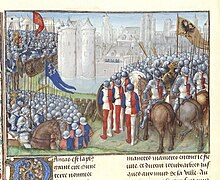

When the Salian dynasty ended with Henry V's death in 1125, the princes chose not to elect the next of kin, but rather Lothair III, the moderately powerful but already old duke of Saxony. When he died in 1137, the princes again aimed to check royal power; accordingly they did not elect Lothair's favoured heir, his son-in-law, Henry the Proud of the Welf family, but Conrad III of the Hohenstaufen family, the grandson of Emperor Henry IV and nephew of Emperor Henry V. This led to over a century of strife between the two houses. Conrad ousted the Welfs from their possessions, but after his death in 1152, his nephew Frederick Barbarossa succeeded him and made peace with the Welfs, restoring his cousin Henry the Lion to his – albeit diminished – possessions.
The Hohenstaufen rulers increasingly lent land to "ministeriales", formerly non-free servicemen, who Frederick hoped would be more reliable than dukes. Initially used mainly for war services, this new class of people would form the basis for the later knights, another basis of imperial power. A further important constitutional move at Roncaglia was the establishment of a new peace mechanism for the entire empire, the Landfrieden, with the first imperial one being issued in 1103 under Henry IV at Mainz. This was an attempt to abolish private feuds, between the many dukes and other people, and to tie the emperor's subordinates to a legal system of jurisdiction and public prosecution of criminal acts – a predecessor of the modern concept of rule of law. Another new concept of the time was the systematic founding of new cities by the emperor and by the local dukes. These were partly a result of the explosion in population; they also concentrated economic power at strategic locations. Before this, cities had only existed in the form of old Roman foundations or older bishoprics. Cities that were founded in the 12th century include Freiburg, possibly the economic model for many later cities, and Munich.
Frederick Barbarossa was crowned emperor in 1155. He emphasized the "Romanness" of the empire, partly in an attempt to justify the power of the emperor independent of the (now strengthened) pope. An imperial assembly at the fields of Roncaglia in 1158 reclaimed imperial rights in reference to Justinian I's Corpus Juris Civilis. Imperial rights had been referred to as regalia since the Investiture Controversy but were enumerated for the first time at Roncaglia. This comprehensive list included public roads, tariffs, coining, collecting punitive fees, and the seating and unseating of office-holders. These rights were now explicitly rooted in Roman law, a far-reaching constitutional act.
Frederick's policies were primarily directed at Italy, where he clashed with the free-minded cities of the north, especially the Duchy of Milan. He also embroiled himself in another conflict with the Papacy by supporting a candidate elected by a minority against Pope Alexander III (1159–1181). Frederick supported a succession of antipopes before finally making peace with Alexander in 1177. In Germany, the emperor had repeatedly protected Henry the Lion against complaints by rival princes or cities (especially in the cases of Munich and Lübeck). Henry gave only lackluster support to Frederick's policies, and, in a critical situation during the Italian wars, Henry refused the emperor's plea for military support. After returning to Germany, an embittered Frederick opened proceedings against the duke, resulting in a public ban and the confiscation of all Henry's territories. In 1190, Frederick participated in the Third Crusade, dying in the Armenian Kingdom of Cilicia.
During the Hohenstaufen period, German princes facilitated a successful, peaceful eastward settlement of lands that were uninhabited or inhabited sparsely by West Slavs. German-speaking farmers, traders, and craftsmen from the western part of the Empire, both Christians and Jews, moved into these areas. The gradual Germanization of these lands was a complex phenomenon that should not be interpreted in the biased terms of 19th-century nationalism. The eastward settlement expanded the influence of the empire to include Pomerania and Silesia, as did the intermarriage of the local, still mostly Slavic, rulers with German spouses. The Teutonic Knights were invited to Prussia by Duke Konrad of Masovia to Christianize the Prussians in 1226. The monastic state of the Teutonic Order (Deutschordensstaat) and its later German successor state of the Duchy of Prussia was never part of the Holy Roman Empire.
Under the son and successor of Frederick Barbarossa, Henry VI, the Hohenstaufen dynasty reached its apex, with the addition of the Norman kingdom of Sicily through the marriage of Henry VI and Constance of Sicily. Bohemia and Poland were under feudal dependence, while Cyprus and Lesser Armenia also paid homage. The Iberian-Moroccan caliph accepted his claims over the suzerainty over Tunis and Tripolitania and paid tribute. Fearing the power of Henry, the most powerful monarch in Europe since Charlemagne, the other European kings formed an alliance. But Henry broke this coalition by blackmailing English king Richard the Lionheart. The Byzantine emperor worried that Henry would turn his Crusade plan against his empire, and began to collect the alamanikon to prepare against the expected invasion. Henry also had plans for turning the Empire into a hereditary monarchy, although this met with opposition from some of the princes and the pope. The emperor suddenly died in 1197, leading to the partial collapse of his empire. As his son, Frederick II, though already elected king, was still a small child and living in Sicily, German princes chose to elect an adult king, resulting in the dual election of Frederick Barbarossa's youngest son Philip of Swabia and Henry the Lion's son Otto of Brunswick, who competed for the crown. After Philip was murdered in a private squabble in 1208, Otto prevailed for a while, until he began to also claim Sicily.

Pope Innocent III, who feared the threat posed by a union of the empire and Sicily, was now supported by Frederick II, who marched to Germany and defeated Otto. After his victory, Frederick did not act upon his promise to keep the two realms separate. Though he had made his son Henry king of Sicily before marching on Germany, he still reserved real political power for himself. This continued after Frederick was crowned emperor in 1220. Fearing Frederick's concentration of power, the pope finally excommunicated him. Another point of contention was the Crusade, which Frederick had promised but repeatedly postponed. Now, although excommunicated, Frederick led the Sixth Crusade in 1228, which ended in negotiations and a temporary restoration of the Kingdom of Jerusalem.
For his many-sided activities, prestige, and dynamic personality Frederick II has been called the greatest of all the medieval German emperors. In the Kingdom of Sicily and much of Italy, Frederick built upon the work of his Norman predecessors and forged an early absolutist state bound together by an efficient secular bureaucracy. Despite his imperial prestige and power, Frederick II's rule was a major turning point toward the partitioning of central rule in the Empire. Since his political focus was south of the Alps, he was mostly absent from Germany and issued far-reaching privileges to Germany's secular and ecclesiastical princes to ensure their cooperation. In the 1220 Confoederatio cum principibus ecclesiasticis, Frederick gave up a number of regalia in favour of the bishops, among them tariffs, coining, and the right to build fortification. The 1232 Statutum in favorem principum mostly extended these privileges to secular territories. Although many of these privileges had existed earlier, they were now granted globally, and once and for all, to allow the German princes to maintain order north of the Alps while Frederick concentrated on Italy. The 1232 document marked the first time that the German dukes were called domini terrae, owners of their lands, a remarkable change in terminology as well. the Statutum affirmed a division of labor between the emperor and the princes and laid much groundwork for the development of particularism in Germany. Even so, from 1232 the vassals of the emperor had a veto over imperial legislative decisions and any new law established by the emperor had to be approved by the princes.
These provisions not withstanding, royal power in Germany remained strong under Frederick and by the 1240s the crown was still rich in fiscal resources, land holdings, retinues, and all other rights, revenues, and jurisdictions. Frederick II used the political loyalty and practical jurisdictions granted to the higher German aristocracy to impose peace, order, and justice upon Germany. The jurisdictional autarky of the German princes was favoured by the crown itself in the twelfth and thirteenth centuries in the interests of order and local peace. The inevitable result was the territorial particularism of churchmen, lay princes, and interstitial cities. However, Frederick was a ruler of vast territories and "could not be everywhere at once". The transference of jurisdiction was a practical solution to secure the further support of the German princes and, moreover, was a process which had already been underway even under Henry VI and Frederick Barbarossa. It is unlikely that a particularly "strong ruler" such as Frederick II would have even pragmatically agreed to legislation that was truly concessionary rather than cooperative, neither would the princes have insisted on such. The Mainz Landfriede or Constitutio Pacis, decreed at the Imperial Diet of 1235, became one of the basic laws of the empire and provided that the princes should share the burden of local government in Germany. The authority of the crown was not in question, rather its practical allocation in such a wide region which lacked a general administrative apparatus. Far from a broad diminution of royal power, the Mainz Landfriede was a constitutional recalibration based on the culmination of multi-decade political realities and a testament to Frederick II's considerable political strength, his increased prestige during the early 1230s, and sheer overpowering might that he succeeded in securing the princes' support and rebound them to Hohenstaufen power.
Kingdom of Bohemia
The Kingdom of Bohemia was a significant regional power during the Middle Ages. In 1212, King Ottokar I (bearing the title "king" since 1198) extracted a Golden Bull of Sicily (a formal edict) from Emperor Frederick II, confirming the royal title for Ottokar and his descendants, and the Duchy of Bohemia was raised to a kingdom. Bohemia's political and financial obligations to the Empire were gradually reduced. Charles IV set Prague to be the seat of the Holy Roman emperor.
Interregnum
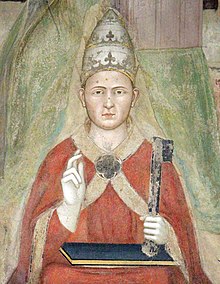
After the death of Frederick II in 1250, Conrad IV, Frederick's son (died 1254), enjoyed a strong position having defeated his papal-backed rival anti-king, William of Holland (died 1256). However, Conrad's death was followed by the Interregnum, during which no king could achieve universal recognition, allowing the princes to consolidate their holdings and become even more independent as rulers. After 1257, the crown was contested between Richard of Cornwall, who was supported by the Guelph party, and Alfonso X of Castile, who was recognized by the Hohenstaufen party but never set foot on German soil. After Richard's death in 1273, Rudolf I of Germany, a minor pro-Hohenstaufen count, was elected. He was the first of the Habsburgs to hold a royal title, but he was never crowned emperor. After Rudolf's death in 1291, Adolf and Albert were two further weak kings who were never crowned emperor.
Albert was assassinated in 1308. Almost immediately, King Philip IV of France began aggressively seeking support for his brother, Charles of Valois, to be elected the next king of the Romans. Philip thought he had the backing of the French Pope, Clement V (established at Avignon in 1309), and that his prospects of bringing the empire into the orbit of the French royal house were good. He lavishly spread French money in the hope of bribing the German electors. Although Charles of Valois had the backing of pro-French Henry, Archbishop of Cologne, many were not keen to see an expansion of French power, least of all Clement V. The principal rival to Charles appeared to be Count Palatine Rudolf II.
But the electors, the great territorial magnates who had lived without a crowned emperor for decades, were unhappy with both Charles and Rudolf. Instead Count Henry of Luxembourg, with the aid of his brother, Archbishop Baldwin of Trier, was elected as Henry VII with six votes at Frankfurt on 27 November 1308. Though a vassal of King Philip, Henry was bound by few national ties, and thus suitable as a compromise candidate. Henry VII was crowned king at Aachen on 6 January 1309, and emperor by Pope Clement V on 29 June 1312 in Rome, ending the interregnum.
Changes in political structure
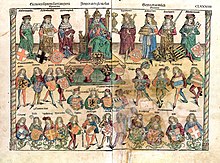
During the 13th century, a general structural change in how land was administered prepared the shift of political power toward the rising bourgeoisie at the expense of the aristocratic feudalism that would characterize the Late Middle Ages. The rise of the cities and the emergence of the new burgher class eroded the societal, legal and economic order of feudalism.
Peasants were increasingly required to pay tribute to their landlords. The concept of property began to replace more ancient forms of jurisdiction, although they were still very much tied together. In the territories (not at the level of the Empire), power became increasingly bundled: whoever owned the land had jurisdiction, from which other powers derived. Jurisdiction at the time did not include legislation, which was virtually nonexistent until well into the 15th century. Court practice heavily relied on traditional customs or rules described as customary.
During this time, territories began to transform into the predecessors of modern states. The process varied greatly among the various lands and was most advanced in those territories that were almost identical to the lands of the old Germanic tribes, e.g., Bavaria. It was slower in those scattered territories that were founded through imperial privileges.
In the 12th century the Hanseatic League established itself as a commercial and defensive alliance of the merchant guilds of towns and cities in the empire and all over northern and central Europe. It dominated marine trade in the Baltic Sea, the North Sea and along the connected navigable rivers. Each of the affiliated cities retained the legal system of its sovereign and, with the exception of the Free imperial cities, had only a limited degree of political autonomy. By the late 14th century, the powerful league enforced its interests with military means, if necessary. This culminated in a war with the sovereign Kingdom of Denmark from 1361 to 1370. The league declined after 1450.
Late Middle Ages
Rise of the territories after the Hohenstaufens
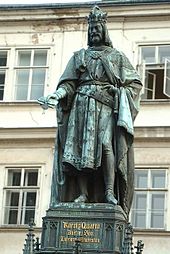
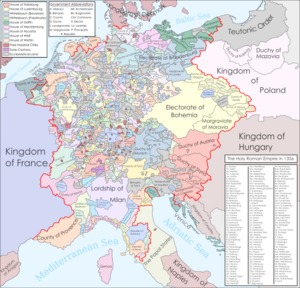
The difficulties in electing the king eventually led to the emergence of a fixed college of prince-electors (Kurfürsten), whose composition and procedures were set forth in the Golden Bull of 1356, issued by Charles IV (reigned 1355–1378, King of the Romans since 1346), which remained valid until 1806. This development probably best symbolizes the emerging duality between emperor and realm (Kaiser und Reich), which were no longer considered identical. The Golden Bull also set forth the system for election of the Holy Roman Emperor. The emperor now was to be elected by a majority rather than by consent of all seven electors. For electors the title became hereditary, and they were given the right to mint coins and to exercise jurisdiction. Also it was recommended that their sons learn the imperial languages – German, Latin, Italian, and Czech. The decision by Charles IV is the subject of debates: on one hand, it helped to restore peace in the lands of the Empire, that had been engulfed in civil conflicts after the end of the Hohenstaufen era; on the other hand, the "blow to central authority was unmistakable". Thomas Brady Jr. opines that Charles IV's intention was to end contested royal elections (from the Luxembourghs' perspective, they also had the advantage that the King of Bohemia had a permanent and preeminent status as one of the Electors himself). At the same time, he built up Bohemia as the Luxembourghs' core land of the Empire and their dynastic base. His reign in Bohemia is often considered the land's Golden Age. According to Brady Jr. though, under all the glitter, one problem arose: the government showed an inability to deal with the German immigrant waves into Bohemia, thus leading to religious tensions and persecutions. The imperial project of the Luxembourgh halted under Charles's son Wenceslaus (reigned 1378–1419 as King of Bohemia, 1376–1400 as King of the Romans), who also faced opposition from 150 local baronial families.
The shift in power away from the emperor is also revealed in the way the post-Hohenstaufen kings attempted to sustain their power. Earlier, the Empire's strength (and finances) greatly relied on the Empire's own lands, the so-called Reichsgut, which always belonged to the king of the day and included many Imperial Cities. After the 13th century, the relevance of the Reichsgut faded, even though some parts of it did remain until the Empire's end in 1806. Instead, the Reichsgut was increasingly pawned to local dukes, sometimes to raise money for the Empire, but more frequently to reward faithful duty or as an attempt to establish control over the dukes. The direct governance of the Reichsgut no longer matched the needs of either the king or the dukes.
The kings beginning with Rudolf I of Germany increasingly relied on the lands of their respective dynasties to support their power. In contrast with the Reichsgut, which was mostly scattered and difficult to administer, these territories were relatively compact and thus easier to control. In 1282, Rudolf I thus lent Austria and Styria to his own sons. In 1312, Henry VII of the House of Luxembourg was crowned as the first Holy Roman Emperor since Frederick II. After him all kings and emperors relied on the lands of their own family (Hausmacht): Louis IV of Wittelsbach (king 1314, emperor 1328–1347) relied on his lands in Bavaria; Charles IV of Luxembourg, the grandson of Henry VII, drew strength from his own lands in Bohemia. It was thus increasingly in the king's own interest to strengthen the power of the territories, since the king profited from such a benefit in his own lands as well.
Imperial Reform

The "constitution" of the Empire still remained largely unsettled at the beginning of the 15th century. Feuds often happened between local rulers. The "robber baron" (Raubritter) became a social factor.
Simultaneously, the Catholic Church experienced crises of its own, with wide-reaching effects in the Empire. The conflict between several papal claimants (two anti-popes and the "legitimate" Pope) ended only with the Council of Constance (1414–1418); after 1419 the Papacy directed much of its energy to suppressing the Hussites. The medieval idea of unifying all Christendom into a single political entity, with the Church and the Empire as its leading institutions, began to decline.
With these drastic changes, much discussion emerged in the 15th century about the Empire itself. Rules from the past no longer adequately described the structure of the time, and a reinforcement of earlier Landfrieden was urgently needed.
The vision for a simultaneous reform of the Empire and the Church on a central level began with Sigismund (reigned 1433–1437, King of the Romans since 1411), who, according to historian Thomas Brady Jr., "possessed a breadth of vision and a sense of grandeur unseen in a German monarch since the thirteenth century". But external difficulties, self-inflicted mistakes and the extinction of the Luxembourg male line made this vision unfulfilled.
Frederick III was the first Habsburg to be crowned Holy Roman Emperor, in 1452. He had been very careful regarding the reform movement in the empire. For most of his reign, he considered reform as a threat to his imperial prerogatives. He avoided direct confrontations, which might lead to humiliation if the princes refused to give way. After 1440, the reform of the Empire and Church was sustained and led by local and regional powers, particularly the territorial princes. In his last years, he felt more pressure on taking action from a higher level. Berthold von Henneberg, the Archbishop of Mainz, who spoke on behalf of reform-minded princes (who wanted to reform the Empire without strengthening the imperial hand), capitalized on Frederick's desire to secure the imperial election for his son Maximilian. Thus, in his last years, he presided over the initial phase of Imperial Reform, which would mainly unfold under Maximilian. Maximilian himself was more open to reform, although naturally he also wanted to preserve and enhance imperial prerogatives. After Frederick retired to Linz in 1488, as a compromise, Maximilian acted as mediator between the princes and his father. When he attained sole rule after Frederick's death, he would continue this policy of brokerage, acting as the impartial judge between options suggested by the princes.
Creation of institutions

Major measures for the Reform were launched at the 1495 Reichstag at Worms. A new organ was introduced, the Reichskammergericht, that was to be largely independent from the Emperor. A new tax was launched to finance it, the Gemeine Pfennig, although this would only be collected under Charles V and Ferdinand I, and not fully.
To create a rival for the Reichskammergericht, Maximilian established the Reichshofrat in 1497, which had its seat in Vienna. During Maximilian's reign, this council was not popular though. In the long run, the two Courts functioned in parallel, sometimes overlapping.
In 1500, Maximilian agreed to establish an organ called the Reichsregiment (central imperial government, consisting of twenty members including the Electors, with the Emperor or his representative as its chairman), first organized in 1501 in Nuremberg. But Maximilian resented the new organization, while the Estates failed to support it. The new organ proved politically weak, and its power returned to Maximilian in 1502.
The most important governmental changes targeted the heart of the regime: the chancery. Early in Maximilian's reign, the Court Chancery at Innsbruck competed with the Imperial Chancery (which was under the elector-archbishop of Mainz, the senior Imperial chancellor). By referring the political matters in Tyrol, Austria as well as Imperial problems to the Court Chancery, Maximilian gradually centralized its authority. The two chanceries became combined in 1502. In 1496, the emperor created a general treasury (Hofkammer) in Innsbruck, which became responsible for all the hereditary lands. The chamber of accounts (Raitkammer) at Vienna was made subordinate to this body. Under Paul von Liechtenstein, the Hofkammer was entrusted with not only hereditary lands' affairs, but Maximilian's affairs as the German king too.
Reception of Roman law
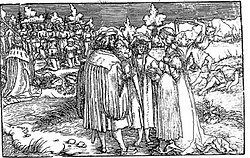
At the 1495 Diet of Worms, the Reception of Roman Law was accelerated and formalized. The Roman Law was made binding in German courts, except in the case it was contrary to local statutes. In practice, it became the basic law throughout Germany, displacing Germanic local law to a large extent, although Germanic law was still operative at the lower courts. Other than the desire to achieve legal unity and other factors, the adoption also highlighted the continuity between the Ancient Roman empire and the Holy Roman Empire. To realize his resolve to reform and unify the legal system, the emperor frequently intervened personally in matters of local legal matters, overriding local charters and customs. This practice was often met with irony and scorn from local councils, who wanted to protect local codes.
The legal reform seriously weakened the ancient Vehmic court (Vehmgericht, or Secret Tribunal of Westphalia, traditionally held to be instituted by Charlemagne but this theory is now considered unlikely), although it would not be abolished completely until 1811 (when it was abolished under the order of Jérôme Bonaparte).
National political culture
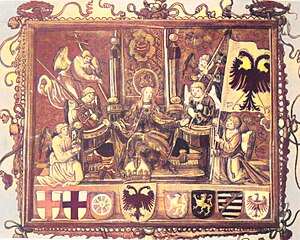
Maximilian and Charles V (despite the fact both emperors were internationalists personally) were the first who mobilized the rhetoric of the Nation, firmly identified with the Reich by the contemporary humanists. With encouragement from Maximilian and his humanists, iconic spiritual figures were reintroduced or became notable. The humanists rediscovered the work Germania, written by Tacitus. According to Peter H. Wilson, the female figure of Germania was reinvented by the emperor as the virtuous pacific Mother of Holy Roman Empire of the German Nation. Whaley further suggests that, despite the later religious divide, "patriotic motifs developed during Maximilian's reign, both by Maximilian himself and by the humanist writers who responded to him, formed the core of a national political culture."
Maximilian's reign also witnessed the gradual emergence of the German common language, with the notable roles of the imperial chancery and the chancery of the Wettin Elector Frederick the Wise. The development of the printing industry together with the emergence of the postal system (the first modern one in the world), initiated by Maximilian himself with contribution from Frederick III and Charles the Bold, led to a revolution in communication and allowed ideas to spread. Unlike the situation in more centralized countries, the decentralized nature of the Empire made censorship difficult.
Terence McIntosh comments that the expansionist, aggressive policy pursued by Maximilian I and Charles V at the inception of the early modern German nation (although not to further the aims specific to the German nation per se), relying on German manpower as well as utilizing fearsome Landsknechte and mercenaries, would affect the way neighbours viewed the German polity, although in the longue durée, Germany tended to be at peace.
Imperial power

Maximilian was "the first Holy Roman Emperor in 250 years who ruled as well as reigned". In the early 1500s, he was true master of the Empire, although his power weakened during the last decade before his death. Whaley notes that, despite struggles, what emerged at the end of Maximilian's rule was a strengthened monarchy and not an oligarchy of princes. Benjamin Curtis opines that while Maximilian was not able to fully create a common government for his lands (although the chancellery and court council were able to coordinate affairs across the realms), he strengthened key administrative functions in Austria and created central offices to deal with financial, political and judicial matters – these offices replaced the feudal system and became representative of a more modern system that was administered by professionalized officials. After two decades of reforms, the emperor retained his position as first among equals, while the empire gained common institutions through which the emperor shared power with the estates.
By the early 16th century, the Habsburg rulers had become the most powerful in Europe, but their strength relied on their composite monarchy as a whole, and not only the Holy Roman Empire (see also: Empire of Charles V). Maximilian had seriously considered combining the Burgundian lands (inherited from his wife Mary of Burgundy) with his Austrian lands to form a powerful core (while also extending toward the east). After the unexpected addition of Spain to the Habsburg Empire, at one point he intended to leave Austria (raised to a kingdom) to his younger grandson Ferdinand. His elder grandson Charles V later gave Spain and most of the Burgundian lands to his son Philip II of Spain, the founder of the Spanish branch, and the Habsburg hereditary lands to his brother Ferdinand, the founder of the Austrian branch.
In France and England, from the 13th century onward, stationary royal residences had begun to develop into capital cities that grew rapidly and developed corresponding infrastructure: the Palais de la Cité and the Palace of Westminster became the respective main residences. This was not possible in the Holy Roman Empire because no real hereditary monarchy emerged, but rather the tradition of elective monarchy prevailed (see: Imperial election) which, in the High Middle Ages, led to kings of very different regional origins being elected (List of royal and imperial elections in the Holy Roman Empire). If they wanted to control the empire and its rebellious regional rulers, they could not limit themselves to their home region and their private palaces. As a result, kings and emperors continued to travel around the empire well into modern times, using their temporary residences (Kaiserpfalz) as transit stations for their itinerant courts. From the late Middle Ages onward, the weakly fortified pfalzen were replaced by imperial castles. It was only King Ferdinand I, the younger brother of the then Emperor Charles V, who moved his main residence to the Vienna Hofburg in the middle of the 16th century, where most of the following Habsburg emperors subsequently resided. Vienna did not become the capital of the empire, just of a Habsburg hereditary state (the Archduchy of Austria). The emperors continued to travel to their elections and coronations at Frankfurt and Aachen, to the Imperial Diets at different places and to other occasions. The Perpetual Diet of Regensburg was based in Regensburg from 1663 to 1806. Rudolf II resided in Prague, the Wittelsbach emperor Charles VII in Munich. A German capital in the true sense only existed in the Second German Empire from 1871, when the Kaiser, Reichstag and Reichskanzler resided in Berlin.

